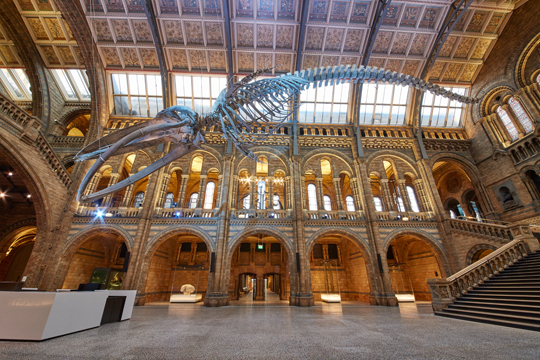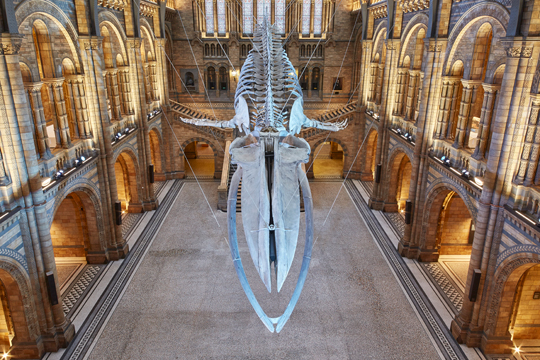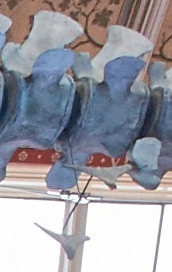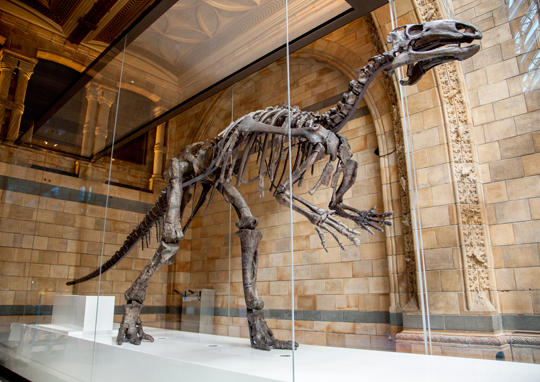A Whale of a Time at the Natural History Museum
Turning our Attention to Mantellisaurus
All change at the Natural History Museum in London with the refurbished main gallery (the Hintze Hall), opening to the public tomorrow. Suspended over the hall, and replacing the Diplodocus cast (Dippy), will be “Hope” a 25.2-metre-long skeleton of a female Blue Whale (Balaenoptera musculus) symbolising the Museum’s focus on conservation and the natural world.
Ready to Greet Millions of Visitors – The Blue Whale Skeleton (Hintze Hall)
Picture credit: The Trustees of the Natural History Museum, London
A Conservation Success – So Far
The whale skeleton, some 4.5 tonnes and all 221 bones of it, had previously been on display in the mammals gallery of the museum but it had been partially hidden from public view. Newly restored and augmented, thanks to some subtle 3-D printing to supplement the bones in the right flipper, this spectacular exhibit is depicted plunging towards the main gallery entrance as if the leviathan is attempting to scoop up visitors. The Blue Whale helps to highlight a conservation success story. Fifty years ago, the Blue Whale population had plummeted to just a few hundred and this, the largest animal known to have existed, was on the verge of extinction. International conservation efforts to help preserve and support populations of baleen whales have paid off, at least in the case of Balaenoptera musculus with an estimated 20,000 individuals swimming the oceans of the world today. Still this represents less than one tenth of the estimated Blue Whale population at the beginning of the 19th century.
A Spectacular Pose for “Hope” the Blue Whale Skeleton
Picture credit: The Trustees of the Natural History Museum, London
A Nod to Whale Evolution
Visitors to the gallery, may miss a tiny pair of bones located under the massive spinal column of the beast. If you look up around the mid-point of the spine you might just be able to make out two tiny triangular bones, supported by wires underneath a vertebra. These are the remains of the hip bones and hind limbs. These bones are not visible in the living animal, they serve no real purpose anymore, except to prove that whales are descended from four-legged, terrestrial animals. In fact, whales (Cetacea), belong in the Order Artiodactyla, the even-toed hoofed mammals and molecular studies suggest their nearest land-living relatives today are the Hippopotamuses (hippos and whales are grouped into the Whippomorpha).
Proof that Whales are Descended from Terrestrial Mammals
Picture credit: The Trustees of the Natural History Museum, London
Lorraine Cornish, the Museum’s Head of Conservation, exclaimed:
“Hope is the only blue whale skeleton in the world to be hung in the diving lunge feeding position. Suspending such a large, complex and historical specimen from a Victorian ceiling was always going to be challenging, but we were determined to show her in as lifelike position as possible and we are thrilled that the result is truly spectacular.”
Wonder Bays – Look out for Mantellisaurus
“Dippy” may have gone but the Hintze Hall will be home to one dinosaur at least. In one of the side bays a mounted skeleton of the iguanodontid Mantellisaurus (M.atherfieldensis) has been put on display.
A Nod to Gideon Mantell – Mantellisaurus
Picture credit: The Trustees of the Natural History Museum, London
The mounted Mantellisaurus specimen represents one of the most complete dinosaur specimens excavated from the UK. At Everything Dinosaur, we think the specimen is NHMUK R5764, if it is, this is the holotype and it was discovered in 1914, by a local fossil collector called Reginald Hooley whilst he was exploring several, large shale blocks near Atherfield Point (Isle of Wight). During his lifetime, Sir Richard Owen, the anatomist who helped found what is now called the Natural History Museum, did a great deal to denigrate the work of his contemporary Gideon Mantell.
Dinosaur fans as well as distinguished palaeontologists we think, will approve of the Museum’s recognition of Mantell’s contribution to the nascent study of dinosaurs. Owen’s statue might look down on the exhibits, but the mounted skeleton, once assigned to the Iguanodon genus, now stands proudly on the eastern side of the Hintze Hall and it bears the name of one of the other great contributors to early palaeontology.
We look forward to visiting the Museum in the near future. We will marvel at the spectacular Blue Whale nodding its head in our direction as we walk in, but in turn we will stand before the Mantellisaurus and nod our heads in recognition of the work of Gideon Mantell who did much to shine a light, where before there was only darkness.
Everything Dinosaur acknowledges the assistance of a media release from the London Natural History Museum in the compilation of this article.
Visit the Everything Dinosaur website: Everything Dinosaur.





